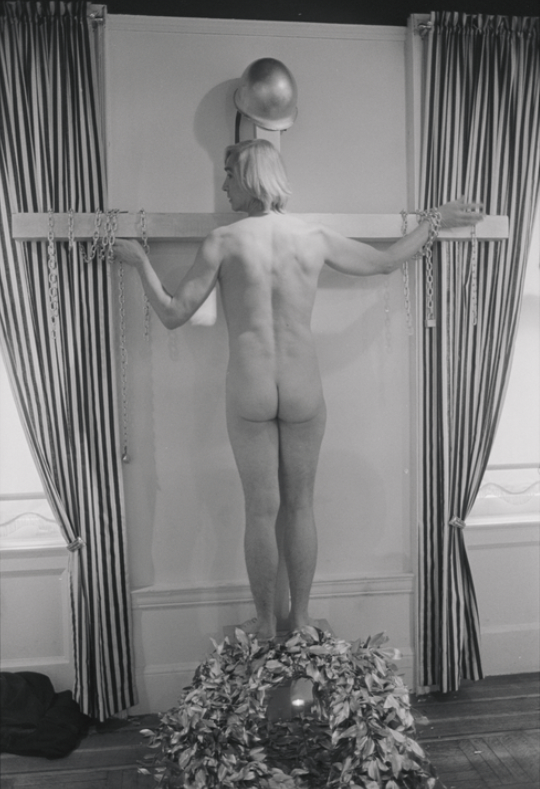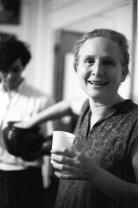Reframing Faith
Created by Kylie Bralczyk on Mon, 04/01/2024 - 14:00
This timeline provides a sociohistorical context for Diana Davies' 1970 The Homosexual

Timeline
Chronological table
| Date | Event | Created by | Associated Places | |
|---|---|---|---|---|
| circa. The start of the month Winter 1960 to circa. The end of the month Winter 1965 |
Meeting and Working With Activists: Sis Cunningham, Gordon Friesen, and Kay Tobin LahusenAt the age of 16, Diana Davies dropped out of high school to instead work at coffeehouses where she was introduced to a plethora of various types of music. As music sparked her interest in her early years, she began working as a musical theatre technician and became interested in photography. As a result, she became acquainted with Sis Cunningham and Gordon Friesen who were both affiliated with human rights activism which started Davie’s interest in human rights photography. Sis Cunningham and Gordon Friesen were such a critical part of Davie’s photography because not only were they so involved in human rights activism, but also victims to imbalances of justice, which Diana was able to recognize. In the early 1960's as well, Diana Davies met Kay Tobin Lahusen and the two ended up successfully collaborating in photography. When collaborating, the two intended "their portrayals as a corrective to the negative images of gays, lesbians, bisexuals, and transgender people in popular culture". In other words, both Davies and Lahusen were determined to challenge negative stereotypes surrounding the LGBTQ+ community. By becoming aware of several social issues during this time, and becoming aqquainted with other activists, Diana used her knowledge of these injustices to create collections of photographs, including “The Homosexual”. Gay, Roxane. Love and Resistance. Roxanne Gay, 2019. Davies, Diana. “Diana Davies Papers.” Smith College Finding Aids, smith.edu/repositories/2/resources/596. Accessed 17 Mar. 2024.
|
Kylie Bralczyk | ||
| 28 Jun 1970 to 28 Jun 1970 |
Christopher Street Liberation Day
In 1970, exactly a year after the Stonewall Riot occurred, “Christopher Street Liberation Day” was held to commemorate the lives lost in the riots. In October of 1969, members of the GLF (Gay Liberation Front), Ellen Broidy, Linda Rhodes, and Foster Gunnison Jr. met with Craig Rodwell at his apartment to discuss an event that would later be known as “Pride”. Thousands of members of the LGBTQ community marched throughout New York City to protest against the injustices placed against homosexuals, which would later be known as America’s first gay pride parade. Members of the community including men, women, drag queens, and trans people all took part in the march, and while excited, were still hesitant in an environment where there was significant hostility to homosexuality. Despite the hesitancy, the parade was successful but not without the presence of religious backlash. Religious protestors held signs that stated “God gave Adam Eve not Steve!” and “Even if you call it a gay family, it's still sinful”. This event is so significant in Davies’, “The Homosexual” because it was a turning point in how society viewed members of the community in the presence of religious backlash. In a time that was hesitant to accept such photographs, Davie created an image that showcased the unfortunate reality of what it meant to be homosexual. Because religion was such a large part of homophobia, the photograph draws this connection and shows how sexuality was constrained in the presence of religion. Christopher Street Gay Liberation Day: The Story of the First Pride." The Rainbow Stores, n.d., https://www.therainbowstores.com/blogs/blogs-guides/christopher-street-gay-liberation-day-the-story-of-the-first-pride. Celebrating Pride: 50 years of the LGBTQ+ movement." CBS News, CBS Interactive Inc., 2022, https://www.cbsnews.com/pictures/50-plus-years-of-lgbt-pride-parades/24/. |
Kylie Bralczyk | ||
| circa. 1977 |
The New Ways MinistryIn the 1970’s, the “New Ways Ministry” was formed within the church to prevent discrimination of LGBTQ+ members. Francis Mugavero, who was a well-known bishop at the time, issued a pastoral letter titled “Sexuality: God’s Gift” in an attempt to defend the rights of homosexuality. In this letter, he stated that they had “been subject to misunderstanding and at times unjust discrimination. This letter is important in the context of the photograph because, despite the church (whose views were used against LGBTQ+ members), defending the community, society ignored it and still heavily relied on Christian morals as a way to discriminate against them. This photograph can be used to emphasize how religion plays such a large part in sexuality and how even in the presence of support from the church, religious views are used to go against them.
When looking at all three of these events, it is important to acknowledge how religion, unfortunately, played a part in the liberation of LGBTQ+ lives. First, when Diana Davies became acquainted with Sis Cunningham, Gordon Friesen, and Kay Tobin Lahusen, she gained a better understanding of how the community was affected as a whole. Without laws that were heavily embedded as a result of religion in history, the activists would not have been able to achieve such success when fighting for LGBTQ+ rights. The “Christopher Street Liberation Day” was also significant when analyzing Davies’, “The Homosexual” because although the event was successful and for the most part, peaceful, there still existed the religious protestors who were actively using their religion as backlash for the movement. Connections can be drawn from “The Homosexual” and “Christopher Street Liberation Day” by acknowledging the cross within the photo which can represent the relationship between religion and homosexuality. Finally, the New Ways Ministry allowed the possibility for a positive relationship between the church and sexuality, despite such an abundance of religious opposition in regards to the community. Since there was a very clear stigma against homosexuals from the church for such an extended period in history, the new ways ministry was a big deal for the liberation movement. It not only defended the idea that homosexuals were accepted in the church but also paved the possibility for religion to cease being an excuse for homophobia. All of the events tied together were important in terms of Diana Davies’, “The Homosexual” because they all showcased the relationship between religion and homosexuality during a time when hostility from the church existed against the LGBTQ+ community. |
Kylie Bralczyk |



